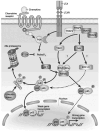Fine tuning the transcriptional regulation of the CXCL1 chemokine
- PMID: 14510072
- PMCID: PMC3140403
- DOI: 10.1016/s0079-6603(03)01009-2
Fine tuning the transcriptional regulation of the CXCL1 chemokine
Abstract
Constitutive activation of the transcription factor nuclear factor-κB (NF-κB) plays a major role in inflammatory diseases as well as cancer by inducing the endogenous expression of many proinflammatory proteins such as chemokines, and facilitating escape from apoptosis. The constitutive expression of chemokines such as CXCL1 has been correlated with growth, angiogenesis, and metastasis of cancers such as melanoma. The transcription of CXCL1 is regulated through interactions of NF-κB with other transcriptional regulatory molecules such as poly(ADP-ribose) polymerase-1 (PARP-1) and cAMP response element binding protein (CREB)-binding protein (CBP). It has been proposed that these two proteins interact with NF-κB and other enhancers to form an enhanceosome at the promoter region of CXCL1 and modulate CXCL1 transcription. In addition to these positive cofactors, a negative regulator, CAAT displacement protein (CDP), may also be involved in the transcriptional regulation of CXCL1. It has been postulated that the elevated expression of CXCL1 in melanomas is due to altered interaction between these molecules. CDP interaction with the promoter down-regulates transcription, whereas PARP and/or CBP interactions enhance transcription. Thus, elucidation of the interplay between components of the enhanceosome of this gene is important in finding more efficient and new therapies for conditions such as cancer as well as acute and chronic inflammatory diseases.
Figures


Similar articles
-
Chemokine-cytokine cross-talk. The ELR+ CXC chemokine LIX (CXCL5) amplifies a proinflammatory cytokine response via a phosphatidylinositol 3-kinase-NF-kappa B pathway.J Biol Chem. 2003 Feb 14;278(7):4675-86. doi: 10.1074/jbc.M207006200. Epub 2002 Dec 4. J Biol Chem. 2003. PMID: 12468547
-
Differential regulation of CXC ligand 1 transcription in melanoma cell lines by poly(ADP-ribose) polymerase-1.Oncogene. 2006 Dec 14;25(59):7714-22. doi: 10.1038/sj.onc.1209751. Epub 2006 Jun 26. Oncogene. 2006. PMID: 16799643 Free PMC article.
-
A role for poly(ADP-ribose) polymerase in the transcriptional regulation of the melanoma growth stimulatory activity (CXCL1) gene expression.J Biol Chem. 2001 Mar 23;276(12):9366-74. doi: 10.1074/jbc.M009897200. Epub 2000 Dec 8. J Biol Chem. 2001. PMID: 11112786 Free PMC article.
-
Role of CXCL1 in tumorigenesis of melanoma.J Leukoc Biol. 2002 Jul;72(1):9-18. J Leukoc Biol. 2002. PMID: 12101257 Free PMC article. Review.
-
Mechanism and biological significance of constitutive expression of MGSA/GRO chemokines in malignant melanoma tumor progression.J Leukoc Biol. 1997 Nov;62(5):588-97. doi: 10.1002/jlb.62.5.588. J Leukoc Biol. 1997. PMID: 9365113 Review.
Cited by
-
Interleukin-8, CXCL1, and MicroRNA miR-146a Responses to Probiotic Escherichia coli Nissle 1917 and Enteropathogenic E. coli in Human Intestinal Epithelial T84 and Monocytic THP-1 Cells after Apical or Basolateral Infection.Infect Immun. 2016 Aug 19;84(9):2482-92. doi: 10.1128/IAI.00402-16. Print 2016 Sep. Infect Immun. 2016. PMID: 27297392 Free PMC article.
-
Elevated CXCL1 expression in breast cancer stroma predicts poor prognosis and is inversely associated with expression of TGF-β signaling proteins.BMC Cancer. 2014 Oct 24;14:781. doi: 10.1186/1471-2407-14-781. BMC Cancer. 2014. PMID: 25344051 Free PMC article.
-
Exploring the importance of predicted camel NRAP exon 4 for environmental adaptation using a mouse model.Anim Genet. 2025 Feb;56(1):e13490. doi: 10.1111/age.13490. Epub 2024 Oct 30. Anim Genet. 2025. PMID: 39478283 Free PMC article.
-
Rac3 induces a molecular pathway triggering breast cancer cell aggressiveness: differences in MDA-MB-231 and MCF-7 breast cancer cell lines.BMC Cancer. 2013 Feb 6;13:63. doi: 10.1186/1471-2407-13-63. BMC Cancer. 2013. PMID: 23388133 Free PMC article.
-
Percutaneous Sampling of Local Biomolecule Gradients Across Coronary Artery Atherosclerotic Plaques.JACC Basic Transl Sci. 2017 Dec 25;2(6):646-654. doi: 10.1016/j.jacbts.2017.07.007. eCollection 2017 Dec. JACC Basic Transl Sci. 2017. PMID: 30062180 Free PMC article.
References
-
- Baggiolini M, Dewald B, Moser B. Interleukin-8 and related chemotactic cytokines—CXC and CC chemokines. Adv Immunol. 1994;55:97–179. - PubMed
-
- Clark-Lewis I, Kim KS, Rajarathnam K, Gong JH, Dewald B, Moser B, Baggiolini M, Sykes BD. Structure-activity relationships of chemokines. J Leukoc Biol. 1995;57:703–711. - PubMed
-
- Clore GM, Appella E, Yamada M, Matsushima K, Gronenborn AM. Three-dimensional structure of interleukin 8 in solution. Biochemistry. 1990;29:1689–1696. - PubMed
-
- Strieter RM, Polverini PJ, Kunkel SL, Arenberg DA, Burdick MD, Kasper J, Dzuiba J, Van Damme J, Walz A, Marriott D, et al. The functional role of the ELR motif in CXC chemokine-mediated angiogenesis. J Biol Chem. 1995;270:27348–27357. - PubMed
Publication types
MeSH terms
Substances
Grants and funding
LinkOut - more resources
Full Text Sources
Miscellaneous
